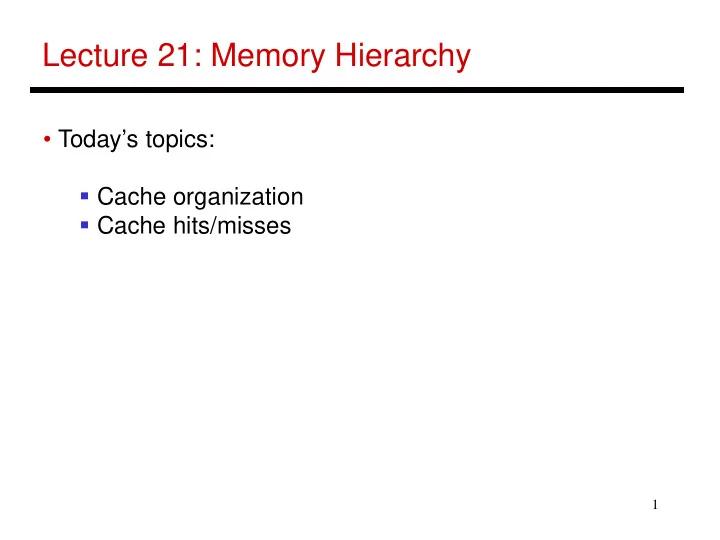

Lecture 21: Memory Hierarchy • Today’s topics: Cache organization Cache hits/misses 1
OoO Wrap-up • How large are the structures in an out-of-order processor? • What are the pros and cons of having larger/smaller structures? 2
Cache Hierarchies • Data and instructions are stored on DRAM chips – DRAM is a technology that has high bit density, but relatively poor latency – an access to data in memory can take as many as 300 cycles today! • Hence, some data is stored on the processor in a structure called the cache – caches employ SRAM technology, which is faster, but has lower bit density • Internet browsers also cache web pages – same concept 3
Memory Hierarchy • As you go further, capacity and latency increase L1 data or Registers Memory instruction L2 cache 1KB 1GB Disk Cache 2MB 1 cycle 300 cycles 32KB 15 cycles 80 GB 10M cycles 2 cycles 4
Locality • Why do caches work? Temporal locality: if you used some data recently, you will likely use it again Spatial locality: if you used some data recently, you will likely access its neighbors • No hierarchy: average access time for data = 300 cycles • 32KB 1-cycle L1 cache that has a hit rate of 95%: average access time = 0.95 x 1 + 0.05 x (301) = 16 cycles 5
Accessing the Cache Byte address 101000 Offset 8-byte words 8 words: 3 index bits Direct-mapped cache: each address maps to a unique cache location. Sets Data array 6
The Tag Array Byte address 101000 Tag 8-byte words Compare Direct-mapped cache: each address maps to a unique address Tag array Data array 7
Example Access Pattern Byte address Assume that addresses are 8 bits long How many of the following address requests are hits/misses? 101000 4, 7, 10, 13, 16, 68, 73, 78, 83, 88, 4, 7, 10… Tag 8-byte words Compare Direct-mapped cache: each address maps to a unique address Tag array Data array 8
Increasing Line Size A large cache line size smaller tag array, Byte address fewer misses because of spatial locality 10100000 32-byte cache Tag line size or Offset block size Tag array Data array 9
Associativity Set associativity fewer conflicts; wasted power Byte address because multiple data and tags are read 10100000 Tag Way-1 Way-2 Tag array Data array Compare 10
Associativity How many offset/index/tag bits if the cache has Byte address 64 sets, each set has 64 bytes, 10100000 4 ways Tag Way-1 Way-2 Tag array Data array Compare 11
Example 1 • 32 KB 4-way set-associative data cache array with 32 byte line sizes • How many sets? • How many index bits, offset bits, tag bits? • How large is the tag array? 12
Example 1 • 32 KB 4-way set-associative data cache array with 32 byte line sizes cache size = #sets x #ways x block size • How many sets? 256 • How many index bits, offset bits, tag bits? 8 5 19 • How large is the tag array? tag array size = #sets x #ways x tag size = 19 Kb = 2.375 KB 13
Example 2 • A pipeline has CPI 1 if all loads/stores are L1 cache hits 40% of all instructions are loads/stores 85% of all loads/stores hit in 1-cycle L1 50% of all (10-cycle) L2 accesses are misses Memory access takes 100 cycles What is the CPI? 14
Example 2 • A pipeline has CPI 1 if all loads/stores are L1 cache hits 40% of all instructions are loads/stores 85% of all loads/stores hit in 1-cycle L1 50% of all (10-cycle) L2 accesses are misses Memory access takes 100 cycles What is the CPI? Start with 1000 instructions 1000 cycles (includes all 400 L1 accesses) + 400 (l/s) x 15% x 10 cycles (the L2 accesses) + 400 x 15% x 50% x 100 cycles (the mem accesses) = 4,600 cycles CPI = 4.6 15
Cache Misses • On a write miss, you may either choose to bring the block into the cache (write-allocate) or not (write-no-allocate) • On a read miss, you always bring the block in (spatial and temporal locality) – but which block do you replace? no choice for a direct-mapped cache randomly pick one of the ways to replace replace the way that was least-recently used (LRU) FIFO replacement (round-robin) 16
Writes • When you write into a block, do you also update the copy in L2? write-through: every write to L1 write to L2 write-back: mark the block as dirty, when the block gets replaced from L1, write it to L2 • Writeback coalesces multiple writes to an L1 block into one L2 write • Writethrough simplifies coherency protocols in a multiprocessor system as the L2 always has a current copy of data 17
Types of Cache Misses • Compulsory misses: happens the first time a memory word is accessed – the misses for an infinite cache • Capacity misses: happens because the program touched many other words before re-touching the same word – the misses for a fully-associative cache • Conflict misses: happens because two words map to the same location in the cache – the misses generated while moving from a fully-associative to a direct-mapped cache 18
Title • Bullet 19
Recommend
More recommend